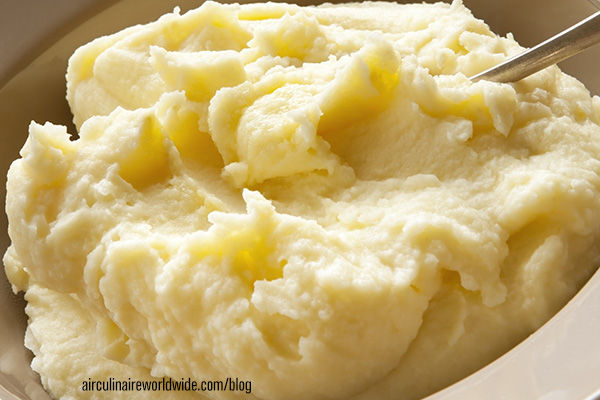Today’s culinary landscape is filled with new ideas and concepts that, at times, can challenge our taste buds and comfort levels. We have seen an increased introduction of ethnic cuisines, unfamiliar ingredients and new cooking techniques from all corners of the world that chefs and restaurateurs have embraced as a way to stand out, be unique and drive interest to their kitchens and restaurants. Trends like camel milk, Polish-Vietnamese fusion, cooking with nitrogen and even eating the dirt your vegetables were grown in (I still don’t get this one!) are just a few attention-grabbing trends that cooks pull out of their toque in order to get noticed.
I love these things — except the dirt thing — and I am always looking for the next earth-shattering cooking “thing,” but I can’t help to think that, as we broaden our culinary horizons, we may be forgetting how to execute the basics. Yes, Karnataka Curried Cold Water Lobster Yukon Gold Whipped Potatoes with Chive Crème Fraiche sounds like a fantastic and very high-end mashed potato. Yet, if you don’t know how to properly make the mashed potatoes, the other words and ingredients become insignificant and wasted.
In this series of articles, I will feature recipes of basic dishes as a return to the foundations of cooking. Not only will I list the ingredients and the method of preparation, but I will also provide reasons why specific ingredients are selected as well as why certain steps are taken to create the dish. With the basic foundation and understanding on how to properly make these dishes it is easy to adapt the recipe for more advanced flavors and styles.
Recipe: Basic Mashed Potatoes
Ingredients
Yukon Gold Potatoes – 32 oz. (910 g)
The Yukon Gold, or Idaho, variety is selected because of its starch content. The high starch content allows the potato to break down easier during the cooking process and allows for better absorption of the dairy products added during the whipping process. Waxy potatoes, like red bliss, do not contain the optimal starch content to absorb the liquids or break down during the cooking process.
Whole Milk – 8 oz. (225 g)
The fat in whole milk binds with the starch in the potato, creating a lighter, fluffier texture. Skim or low fat milk has more water content and less fat causing, the potatoes to become flatter and looser in consistency. Heavy cream is just that, too heavy; the overage of the fat content can cause potatoes to become dense and thick.
Unsalted Butter – 4 oz. (115 g)
More fat means more flavor. The fat and oil in the butter also aids in keeping the potatoes loose and fluffy. Unsalted butter is chosen because you can always add salt later in the process, giving more control over the salt content. Margarine and oils are just that — oils. The addition of oils might cut down the fat content, but with nothing to bind them to the potatoes the oils can separate and become a pool of greasy looking oil around the potatoes.
Kosher Salt – To Taste
The large crystals of kosher salt breakdown and dissolve in liquids better than table salt. Table salt is saltier in flavor than kosher salt, so too much can ruin a batch of otherwise perfect whipped potatoes.
White Pepper – To Taste
This is more of an appearance preference. White pepper blends into the whipped potatoes but still adds the heat. Black pepper is easily seen in the whitish color of whipped potatoes.
Method
- Add cold water to a sauce pot.
- Liberally add salt to the water.
- Peel potatoes and dice into uniform ¾-inch pieces.
- Place them into the cool, salted water so that the water comes to about an inch above the potatoes.
- Cold, salted water is a must when making whipped potatoes.
- The water will keep the potatoes from turning brown.
- The salt prepares the potatoes for absorbing the milk and butter later.
- Uniform cuts allow the potato pieces to cook evenly.
- Large pieces of potatoes keep the potatoes from overcooking and getting mushy.
- Place the pot of potatoes over medium-high heat and bring water to a boil.
- Starting with cold water will keep the potatoes from browning in the pot during cooking.
- Going from cold to boiling water will slowly heat the potatoes through for even cooking.
- Reduce heat to a low boil and continue to cook until potatoes are fork tender.
- Reducing the heat to a low boil will keep the potatoes from cooking unevenly.
- The force and turbulence of boiling water will break apart the potatoes.
- Remove the pan from the heat and pour potatoes into a colander or strainer.
- Drain all the water from the potatoes and evenly spread the potatoes on a sheet pan.
- Draining all the water dries the potatoes out so they are able to absorb all the milk and butter.
- Sheeting out the potatoes keeps them from crushing under their own weight and getting mealy.
- In a sauce pan, combine the whole milk and the butter over low heat.
- Heat until the butter is melted but not separated.
- Adding warmed liquids to the potatoes will keep them from getting cold. If the potatoes get too cold, they become difficult to whip.
- Warm liquid is more easily absorbed by the drained potatoes.
- Add the drained potatoes to a bowl and slowly mash using a potato masher or place the potatoes in a food mill and slowly process.
- The slow process of mashing or processing the potatoes will prevent them from over-releasing the starch. Rapid or over-processing the potatoes will result in wallpaper paste textured mashed potatoes.
- Add the warmed milk and melted butter to the potatoes and, using a rubber spatula or spoon, gently fold the liquid into the potatoes.
- Adding the warmed liquid after the potatoes are mashed or processed evenly distributes the liquid.
- A folding motion of incorporating the liquids into the potatoes will reduce the chance of over-mixing the potatoes and creating too much starch.
- Season to taste with salt and pepper.
- Cold, salted water is a must when making whipped potatoes.
Advanced Applications
Adding other ingredients to this basic recipe can create an enhanced flavor and presentation of the dish.
- Wasabi Paste
- Truffle Oil
- Curry Powder
- Roasted Jalapenos
- Caramelized Apples
- Cambozola Cheese
Enjoyed making this recipe? Follow us on Instagram and tag us in your culinary creations. Need help making this recipe? Tweet @airculinaire for assistance.
Questions?
If you have any questions about this recipe, contact me at rpeterson@airculinaire.com. For questions about in-flight catering, contact weborders@airculinaire.com.






